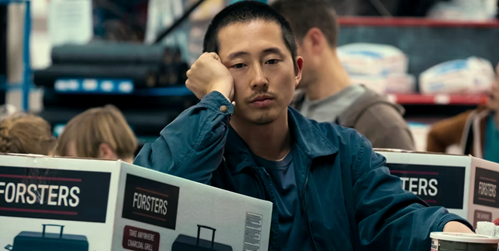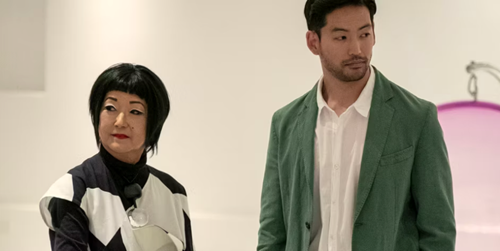Written by Tessa Smith, Screen Rant
Helen Huang, an Emmy and CDGA Award-winning costume designer, is the mind behind the looks for Netflix’s new series Beef. Helen began her career working in fashion editorials and commercials, but it was through scripted television and film that she found her true calling. She says that designing costumes combines her love of art and storytelling.
Beef stars Steven Yeun as Danny and Ali Wong as Amy. The two let a road rage incident burrow into their minds and slowly consume their every thought and action. They come from very different backgrounds, which is wonderfully expressed by their styles of clothing.

How did you get to know the characters for Beef?
Helen Huang: A lot of times I look for projects that are specific, especially contemporary work. I pick showrunners and directors and in their scripts for like a point of view. I like the philosophy of life is weird. Life is Strange, right? And so you should mimic that, and not make it too sterile. Because sometimes I feel like TV can be very sterile. So I specifically look for people to team up with that have a less thorough point of view.
I was looking for an Asian show in general. And then the BEEF script came along and it's fantastic. I know Lee Sung Jin’s work because he did the second season of Dave and I thought that was amazing. I like dark humor with an underlayer of philosophical questioning. When the script came, it was very much like that. When I got into the interview, I said it's an all-Asian cast, so you could really explore what these people look like. There are so many subcultures within the Asian American community, and I really want to do that, and I want to be truthful to that.
How did the way that Danny and Amy’s worlds differ help influence your costume choices?
Helen Huang: Danny's world is definitely something I know very well, because they were like my brothers. They’re from Torrance or from El Segundo. I know exactly how they dress. They probably grew up as skater kids. So I knew that world.
With Amy and George -- I live in Eagle Rock right now, but I used to live in Silver Lake and even though their location is Calabasas, I know who these people are in terms of how they aesthetically dress, which stores they visit, how it represents their house. To me, that was very exciting to show these people unfiltered.
These couple of aesthetic values clashing is exciting too because that's the underlay of the script. They all have their own prejudice against other groups of people. I really wanted the costumes to reflect that.
Were any of the pieces for Beef custom-made?
Helen Huang: We purchased everything. A lot of times on contemporary shows I would custom-make items because sometimes you can't find things in the right color or exactly the right style. But because of the budget of the show, we just couldn't afford to do that. We did end up sourcing a lot of things from just about everywhere. We were ordering online constantly and kept getting banned from online retail. Because we couldn't solely rely on the stores in the city in Los Angeles.
There was a lot of trying on to find the perfect version of something - especially Amy's closet. Lee Sung Jin was very specific. And it’s hard to do so many different cream-colored garments, in a way that would be interesting enough because the palettes are the same. You want it to be enough variety for the audience to realize what her aesthetic is while keeping the palette the same.
How did you select what outfit would be the first one that Amy appeared in?
Helen Huang: We talked to Ali, who is fantastic. She’s very tiny, but she's not afraid of different types of shapes. She wants to be dressed in a very artsy way, which a lot of people don't want to because they think if you wear too much volume it'll make you look unflattering for TV. But Ali’s perspective is not ever, does this make me look flattering or unflattering? She just likes to look cool. So we had a lot of room to play with her silhouettes. She wore a lot of culottes and things that were longer, but it looks good on her. It was hard trying to find garments that were oversized, but just right for her.
For the first outfit, we tried on a bunch of things. I really like hats, but it depends on the director if they want to go for a hat because sometimes, they think it's too distracting for a scene. Or they can't light it properly. But Lee Sung Jin really liked the idea of the hat. And I liked it because it was kind of like an exclamation point. Like the cap on the end of a sentence and it just kind of finished her off. It was also slightly weird, which I like as an intro to Amy because she is very curated, and then she's in this hat. It’s offbeat enough for you to be like, maybe something's not completely right, even though she looks put together.
Similarly, what was the thought process for choosing Danny’s first outfit?
Helen Huang: For Steven’s character, I talked to Lee Sung Jin a lot. I've never worked on a show where I costume so much to memory. He had so many memories of what he was wearing ten, twenty years ago. My idea for Danny was that he’s a guy that's stuck in time. You know those guys. The guys who had an aesthetic and then after 25 they just either stay the same. They wear the same things that they did at 25. It never develops.
With Steven, he was really trying to work through the character. So we would just play and try on all sorts of different things. When we tried on a pair of really, really old Dickies he was like, Oh, I feel so skate. And I was like, Yeah, that's right. Because I just like don't feel like Danny should have some sort of backstory.
People, especially Asian men, when they're in El Segundo, Torrance, which is mostly white areas, they tend to navigate towards a subculture. I like the idea of Danny having a subculture. His clothes were all thrifted. We went to a lot of Goodwill stores and costume houses. So poor Steven didn't have many things that were from a department store. Even the outfit that he wore to the club was a thrifted DKNY shirt and an old pair of DKNY pants from the late 90s. And Lee Sung Jin donated his Structure belt that he had from when he was in High School to complete the look. There were a lot of those small details.
I really hope that with the show someone will see Danny and be like, "Oh, that's me," which they’ve never seen before.


Fumi has a unique look as well. Can you talk about putting that together?
Helen Huang: For me, Fumi was very fun. Her husband was a new Gucci. He’s super famous and very artsy. With Amy, we tried to make her, even though she was very put together, it was more fashion that is more in vogue in now. And with Fumi, we really thought that she dressed in a very artistic way but very different than Amy. She wore Japanese designers a lot. I was like if we're really going to go for this person that dresses in EC Miyagi and stuff, I don't want to tone it down. Because a lot of times shows will ask for that type of aesthetic and then the silhouettes are too baggy or something. And I hate that because that's not who these women are. They don't dress to be body conscious.
I was like, "If we're really going to do this, we really have to do this." And Lee Sung Jin agreed. We did a lot of extreme pieces on her at first, but then she felt a little bit too distracting and too harsh. We went to this store in LA that deals in old Japanese designers and they had replicas and 1980s EC Miyazaki, which felt a lot softer. Also, her jewelry, they're from the 40s and all resin bases because we didn't think Fumi would care for gold or silver. She would want jewelry that was an art piece.
Junie, Amy and George’s daughter, is adorable as well. How did you put together her looks?
Helen Huang: She was very excited because this was her first big thing. When I dress kids for something like this, I think about how their parents are very curated. Their house is very curated. With children, they don't make any money. They don't make a lot of decisions about what they wear unless their parents are giving them options. Even then, the stuff that they have to decide on is what the parents buy them.
The idea is that Junie is a little tiny replica of Amy and George. They're buying her arty designer little kid’s clothes. They’re dressing her in a way that’s not different than how they would furnish their house. It’s an aesthetic that they have for her.
In the final episode, Amy and Danny’s clothes go through a lot. Can you talk about finding the right choices for these scenes?
Helen Huang: It was really hard towards the end, especially with Amy because they wanted an outfit that as good as the first outfit, which was pretty much a perfect outfit. And so, it was very hard trying to come up with something that fit within our budget. I think she had seven of them for the stages that they were in. That was definitely painstaking.
I thought about what we could do to make this impactful, but I pitched the creator the idea of them using their garments in the last episode, in terms of shielding from the sun. He really liked that idea. Then, when I saw that blouse, I was like Oh, it has a detachable collar. Ali really loved it too because she was like, oh, I can put it on my head, I can use it to wipe my brow. It’s a functional garment that is like an onion, you know? We tried to really think it out in terms of like, what that last episode is.